Selling.
It’s the one thing you need to do to make your business survive…
But it’s also one of the most hated aspects of entrepreneurship.
So wouldn’t it be nice to have a personal “online salesperson” who does all your selling for you?
One that does the heavy lifting 24 hours a day, 7 days a week, 365 days a year, making you money while you sleep, lay on the beach in Bali or grow your business into the empire it deserves to be?
The good news is, this already sort of exists. It’s your email autoresponder sales sequence. When used strategically, your autoresponder can act as your personal online salesperson who silently and diligently sells in the background for you, so you don’t have to.
And the best part is?
It’s called an autoresponder for a reason. Instead of spending hours each week carefully crafting pitch emails, hunting for sales on Twitter and dreaming up new ways to sell your product, you can set it and forget it.
Create your autoresponder series once…
And it will sell for you on autopilot for years to come with zero extra effort. #dreamcometrue
In this article, I’ll show you how. I’ll go over:
What to send to your subscribers
When to send it to them, and
How all the pieces fit together to make absolutely certain you’re optimizing for sales.
Even if you have no clue where to start, this guide is the perfect email automation plan to deliver the highest amount of sales possible for your business, all in an ethical and psychologically “strategic” way.
I’ve used this exact email sequence to generate multiple 6-figures sales for clients in a wide variety of niches.
And if that’s not enough, you get to continually rack up those sales even after you’ve clocked out for the holidays.
Before you get into it, let's increase those sales even more by converting more of the people who land on your sales page from this email sequence with your free conversion rate optimization checklist:
Click here to get the spreadsheet (FREE) and increase your conversions.
Now, grab some eggnog and let’s get started:
Email #1: The Welcome Email
When to send: Send this email on “Day 0” -- as soon as the subscriber signs up for your email list.
Want to hear something crazy?
50-60% of all "welcome" emails get opened.
This number is shocking because the average email open rate sags down in the low 20%s or below.
Just about every email list you join will have a “Welcome” email ready to hit your inbox once you sign up, and it’s a great tool for you to use to build some rapport, thank your new subscriber for joining, and get the ball rolling on their action items and next steps.
Check out this friendly “Welcome” message from one of my favorite content creation tools, Grammarly:
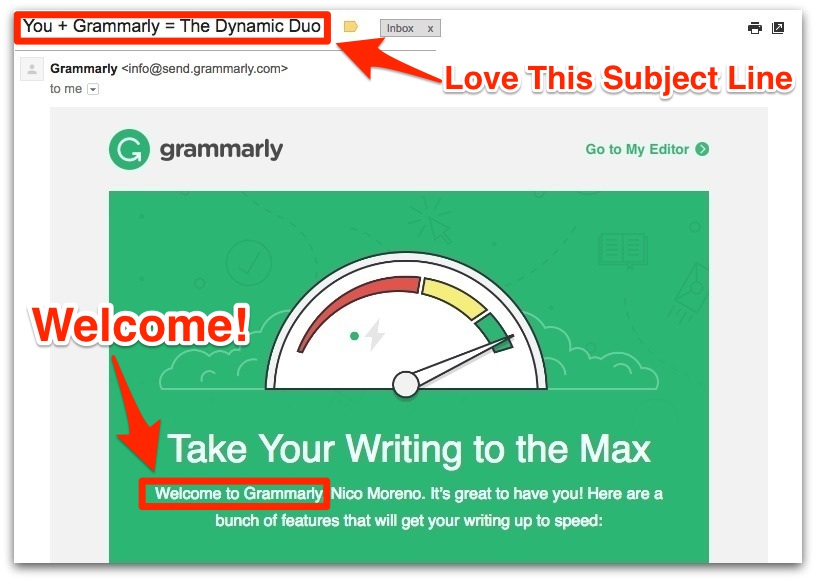
The purpose of The Welcome Email in your sales sequence is to build a relationship with your audience.
You can’t jump right into a sales email. You need to thank your audience, build trust with them and set some expectations.
There are plenty of ways to go about this, but if I were you, I’d take this golden opportunity to learn more about my new subscriber.
Not everyone who opts into your list is going buy from you, but if you can score some quick feedback from them right off the bat, you’ll walk away with a deeper insight into your audience.
Don’t get hung up on the technology, either. Facebook Ads expert Rick Mulready gets thousands of responses from a simple Google Form.
Bryan Harris of VideoFruit does this as well, using this feedback as a content generating machine to fuel his own podcast episodes, and no doubt his products:
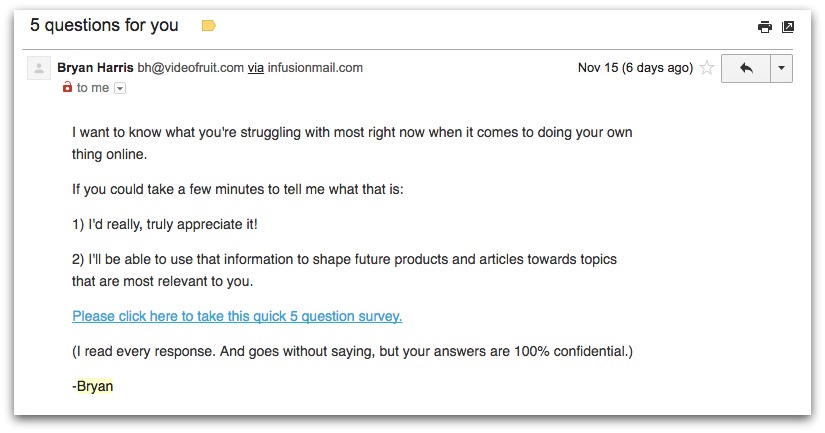
Now that your feedback-collection machine is running on autopilot, it’s time for...
Email #2: The Social Proof Email
When to send: Send this email 1 day after your welcome email.
70% of people are willing to trust a testimonial from someone they’ve never met.
You read that right. The testimonial doesn’t even need to come from a friend.
Why? Because testimonials are a form of social proof: the psychological tendency to do what other people are doing...because if they’re doing it, it must be worthwhile.
Think about it: would you walk into a restaurant that’s completely empty during rush hour? Well, you might, but you’d probably be skeptical about the quality of their food. On the other hand, if you see a restaurant that’s jam-packed, it must be good.
Testimonials serve the same purpose for your business, increasing conversions, credibility and sales.
There are tons of ways you can inject social proof into your sales sequence:
Through a testimonial of someone who’s scored impressive results from your product or service
A 3rd party pitch video from a reliable source
A detailed case study of the results you got from this offering can help new prospects open their minds to the impact you can have on them.
Including a picture of one or two clients or happy customers alongside their testimonial can supercharge your sales, too.
Check out how Ramit Sethi uses a Tweet to act as social proof for one of his premium online courses:
Whatever form of social proof you choose, make sure you focus on the outcome, the results, and the transformation you got your clients or customers, so new prospects can imagine the possibilities for them, too.
Which leads us right into...
Email #3:The Product Demo Email
When to send: Send this email 2 days after The Social Proof Email.
Now that your prospects have seen how your product or service can help someone else, it’s time to lay it all on the table and pick apart exactly what they’re getting so they can make an informed decision about whether your product is right for them.
You can do this through a product demo email.
Take a look at how ClickFunnels CEO Russell Brunson gives you an inside look into his awesome funnel-building software on the big screen:
Even if you run a service-based business and don’t sell software or a physical product, there’s still plenty of room to get creative with your “demo” video.
The only hard requirement is that this email must be thorough, complete, and serve a one-stop resource outlining everything your prospect needs to make their decision.
Include both the features and the benefits, and note that there’s a very clear distinction between the two that many entrepreneurs miss.
Let’s take an online course as an example:
The features of the course might be the lessons and modules
The benefits would be the outcomes: how will this course change your student’s business, life, relationship, or whatever it is your course is all about? How will it take them from point A to point B and transform their lives for the better?
Here’s an example of one of my own offerings, where I clearly separate the benefits of getting my product, and the features of the product itself:
Once you lay it all out in plain sight like this, the sales will start trickling in (if they haven’t already) because by this point, your audience has seen:
the results you can deliver to someone else
how you can help them specifically, and
all the features and benefits they can expect if they buy
But our kickass email sales sequence is just getting started! Next up, is…
Email #4: The Webinar Email
When to send: Send this email 1 day after sending your Product Demo email.
If you had to choose one, would you rather:
scroll through another long-ass article about a product you’re not even sure you’re interested in yet, or...
watch a video explaining the exact same content?
If you picked the video option, I’m right there with you.
Turns out, 4x as many consumers would rather watch a video about a product than read about it. That’s why webinars work so well.
What does this mean for you? It means not having a video of some sort (even if you can’t swing a full-blown webinar) is the kiss of death when it comes to ringing in the new year with a huge influx of sales.
Not only is video a killer way to deliver value to your audience, but also it builds rapport and helps foster a bond that no other type of content can.
And I suggest doing so in a webinar.
“But wait - I don’t have any fancy webinar software! Does that mean I’m off the hook?”
Ha! No way, Jose.
You can stream and record a video right from your computer using YouTube Live, and save it for later so you can deliver it again and again.
And if the thought of holding a webinar totally freaks you out, you can shoot a “selfie-style” video straight from your iPhone or Android (lol) to give it that “personal touch”.
Even a webcast walking your prospect through your product can be just as valuable and get them in an “open-to-buy” mindset.
This simple screencast from Kajabi’s team isn’t more than a couple minutes, but actually lets you peek behind the curtains and get a feel for how their course hosting platform works:
Whether you’re up for creating a value-packed webinar, or only willing to shoot a short screencast, there’s a reason why video content needs to be part of your email sequence - because when you’re passionate about what you do and how you can serve your customer, video lets that shine through in a way that no other form of content can.
Email #5: The Simple Webinar Transcript Email
When to send: Send this email 2 days following your Webinar Email.
Can we be real for a sec?
Not everyone who registered for your webinar is going to end up watching it.
Even a 35-45% show up rate to your webinar is pretty stellar.
And while 4x as many people prefer to watch a video, you can’t forget the other 20% who’d opt for a different route.
Some people will appreciate the abbreviated version and just want to flip through the slides and skim the script. This email needn’t require too much effort - it’s just a friendly nudge saying “Sorry you couldn’t make it-- here’s what you missed”.
Plus, this one is easy-peasy since you’ve already got your webinar content finished up!
Email #6: The Emotional Controversy Email
When to send: Send this email 2 days after the Simple Webinar Transcript Email.
Want to hear some delectably juicy gossip?
Me too.
That’s because controversy, intrigue, and curiosity gets people to perk up and listen.
If someone hasn’t bought from you at this point, you’ll need to powerfully capture their attention with something unconventional and emotional (or downright weird). That’s what you’ll do in this email.
This email should be controversial, uncomfortable, or stir up a powerful emotional response. The 6 main psychology triggers that get us to act are:
Fear
Curiosity
Desire
Shock & Awe
Authority
Humor
If you can get your audience feeling one of these emotions about your product or service, you’re well on your way to making a sale.
Maybe you’ve got a controversial study that’s a hot topic of debate within your niche. Or maybe you’ve crafted a blog post where you’re taking a firm stance against something in your niche that’s wildly popular.
Here’s a fantastic example of an email from Amy Porterfield that taps into the primal fears of exposure and vulnerability that come with building your first online course:
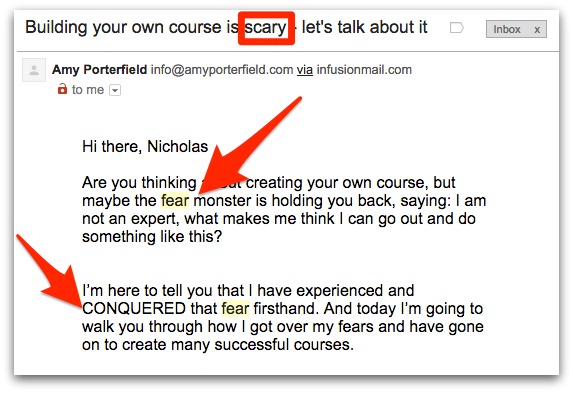
Sure enough, she offers a solution-- Courses that Convert -- to address the fears and frustrations she agitates in this killer sales email.
Can you shock your subscribers with some results that inspire awe? Can you establish authority through social proof or providing massive value? Maybe you can trigger fear to help them see what they might be missing if they don’t buy.
Use the emotional controversy email to convert the “on the fence” buyers.
Email #7: The Webinar “Last Chance” Email
When to send: Send this email 2 days after your Emotional Controversy Email.
If you have the technology, most webinar systems or content delivery systems will let you expire a Webinar replay after a certain point.
If you can figure out a way to add a sense of (truthful) urgency to your webinar, or any aspect of your sales process for that matter, you’ll see a sharp increase in sales.
Just like cramming for finals in college and somehow pulling off an “A”, there’s a reason urgency can be so powerful: because it forces you to act, whether or not you feel “ready”. Maybe your product isn’t for them right now. That’s completely fine, but you want to get them to make a clear and informed decision either way.
You’ve probably been bombarded with marketing using psychological tactic to spike up their sales . Take this “urgency” email from REI that just landed in my inbox this morning:
Pair the urgency with an “action color” like REI does, and this email is sure to bring a hoard of hungry buyers back to your site, on-demand.
Email #8: A Discount Coupon For Non-Buyers
When to send: Send this email 3 days after your Webinar “Last Chance” Email.
Depending on how badly you want the sale, this may or may not be for you. But this sales sequence is designed to… well, sell.
It’s time to give it one last shot: offer your customer the chance to nab a discount coupon and be on their merry way.
If it’s a digital product you’re selling, you might be more inclined to go this route than with a physical product (depending on your profit margins) so again, this is something you’ll need to consider how much sense it makes for your business.
Here’s a beautiful example of how Simple Green Smoothies offers subscribers a sweet deal on a 50% discount:
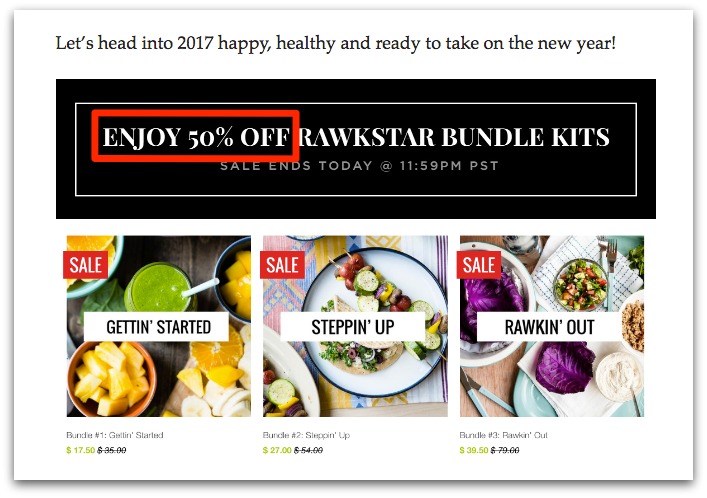
Pair it with a sense of urgency like this email does, and you’ve got a high-converting email to finish off this knockout email sales sequence and ring in the new year with sales up to your eyeballs.
STOP Letting Handfuls of Sales Fall Through The Cracks
As we’re finishing off the holiday season and heading into 2017, it’s time to give your email marketing strategy a fresh new kick.
I’ve just laid out the perfect Email Sales Sequence practically guaranteed to supercharge your sales and take your revenue to a whole new level.
But before you clock out for the holidays, remember this:
Sales is a process. While your emails can do most of the heavy lifting, you need to implement this email sequence if you want to enjoy the benefits of having your very own “automated salesperson” working for you ‘round the clock.
There’s a reason that 6, 7, and even 8 figure businesses rely on this proven email sequence: because it works.
Stop letting your sales fall through the cracks and get started implementing these strategies right away.
Oh, and getting clicks from your emails is only half the battle. Increase your conversion rate when your subscriber lands on your website or landing page with our FREE conversion rate optimization checklist.
Click here to get the spreadsheet (FREE) and increase your conversions


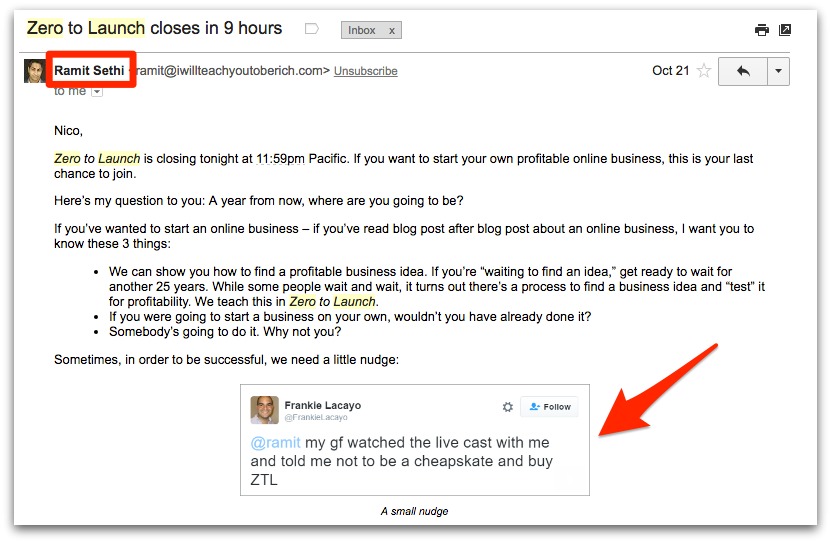
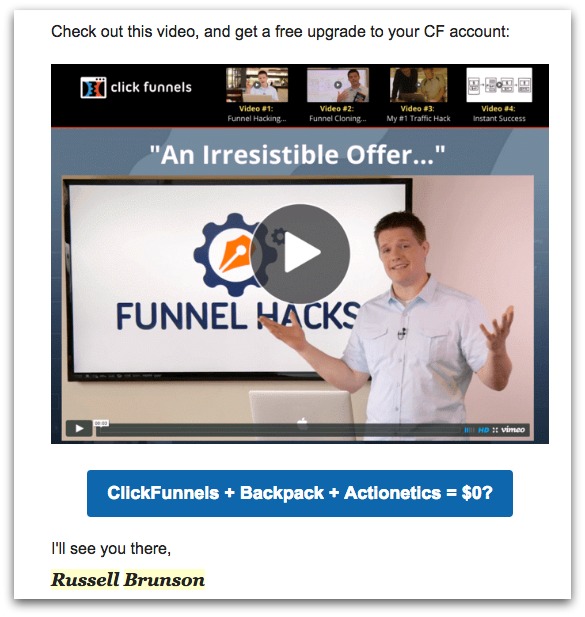
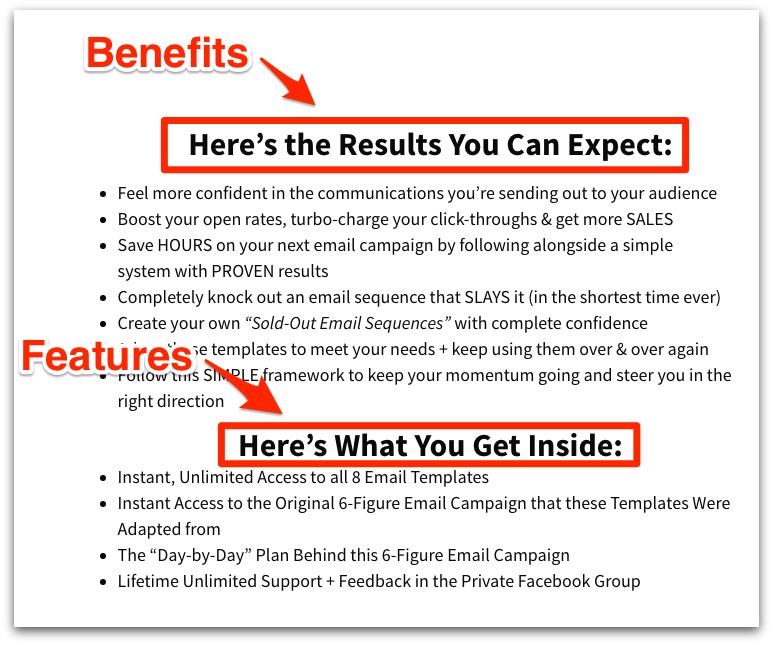
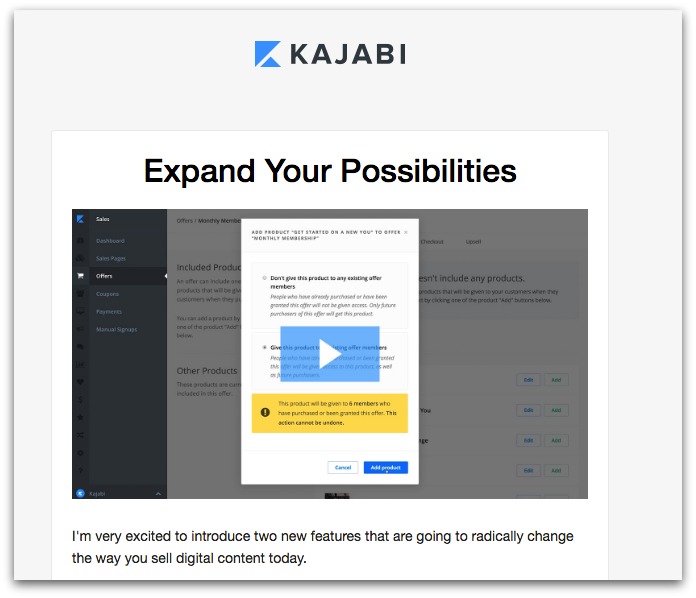
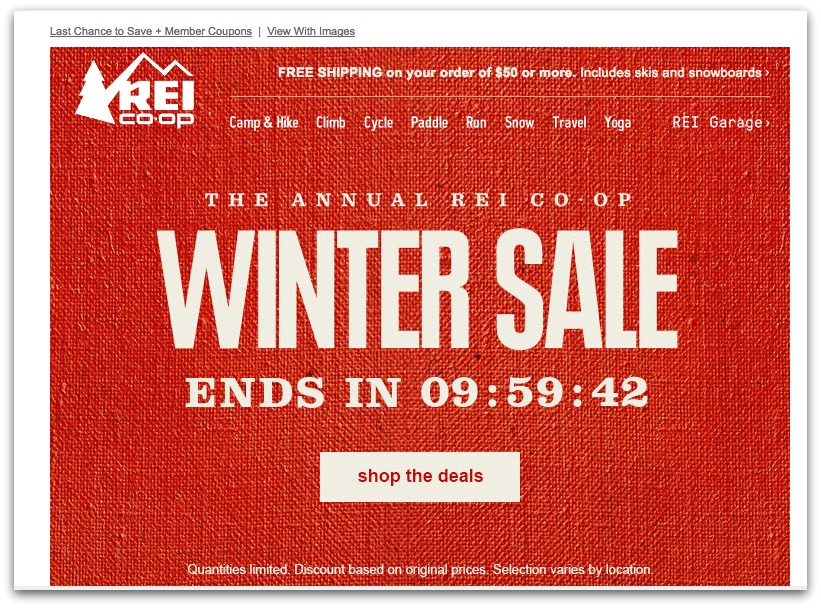
Comments